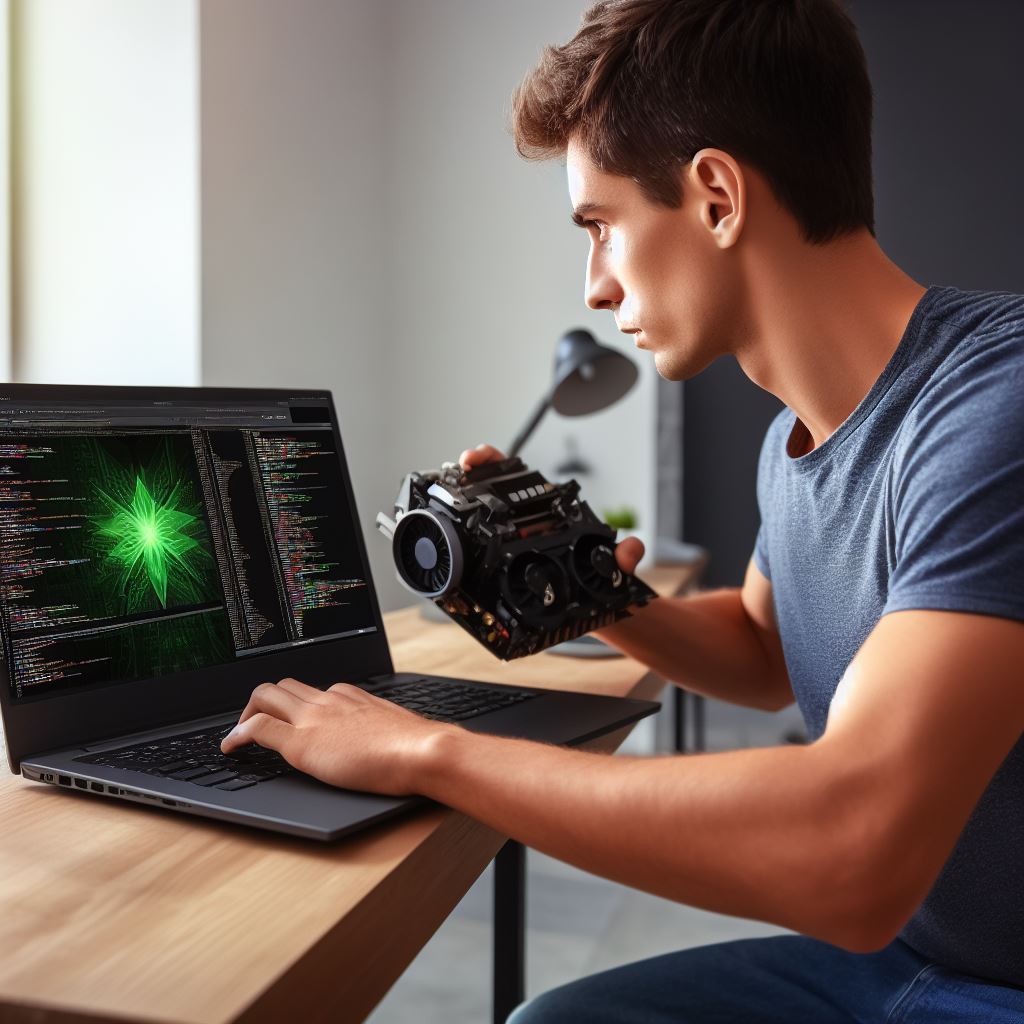Introduction
In this blog post, we will discuss the importance of GPU (Graphics Processing Unit) in a laptop for graphic coding.
Definition of GPU
A GPU, or Graphics Processing Unit, is a specialized electronic circuit that accelerates the creation and rendering of images, animations, and videos.
Brief explanation of graphic coding
Graphic coding involves writing and designing software programs specifically for creating and manipulating visual elements, such as images, videos, and animations.
Purpose of the blog post
The purpose of this blog post is to highlight the significance of having a powerful GPU in a laptop for graphic coding tasks.
The Role of GPU in Graphic Coding
Graphic coding is an essential aspect of modern software development, especially in the realm of visual effects, game development, and computer-aided design.
To achieve high-quality graphics and seamless user experiences, having a dedicated Graphics Processing Unit (GPU) in a laptop becomes crucial.
Here, we will explore the importance of GPU in graphic coding and its advantages over integrated graphics.
Explanation of the GPU’s Importance in Processing Graphics and Visuals
A GPU is a specialized electronic circuit designed to handle and accelerate the creation, rendering, and manipulation of images, animations, and videos.
It works in conjunction with the Central Processing Unit (CPU) to offload graphics-related tasks, allowing for faster processing and smoother graphical performance.
By providing dedicated processing power for graphics, the GPU significantly improves the efficiency and realism of visual outputs.
Enhanced Performance and Efficiency with a Dedicated GPU
Utilizing a dedicated GPU in a laptop while performing graphic coding tasks offers several advantages:
- Superior Graphics Rendering: A dedicated GPU has its own resources and memory, enabling it to handle complex calculations and rendering tasks more efficiently. This results in faster frame rates, better image quality, and smoother animations.
- Parallel Processing: GPUs excel at parallel processing, allowing them to simultaneously execute multiple tasks and handle large amounts of data. This parallelism accelerates real-time visualization and computational tasks, providing faster feedback during development.
- Optimized Software Support: Many graphic coding frameworks and libraries are specifically designed to leverage the power of GPUs. These frameworks offer functionalities like shader programming and hardware acceleration, allowing developers to fully utilize the capabilities of dedicated GPUs.
- Future-Proofing: With advancements in technology, graphic demands continue to grow. Having a laptop with a dedicated GPU ensures compatibility with future software updates and emerging graphic coding techniques, empowering developers to stay at the forefront of innovation.
Comparison to Integrated Graphics
While integrated graphics, which utilize the CPU for graphical tasks, have improved over the years, they are still significantly outperformed by dedicated GPUs.
Integrated graphics typically share system resources, including memory, with the CPU.
This shared resource allocation limits their performance and capabilities, making them less suitable for demanding graphics-intensive applications.
The use of a dedicated GPU in a laptop leads to a superior coding experience and allows developers to achieve the desired graphical fidelity.
Tech Consulting Tailored to Your Coding Journey
Get expert guidance in coding with a personalized consultation. Receive unique, actionable insights delivered in 1-3 business days.
Get StartedEssentially, a dedicated GPU is of utmost importance for graphic coding in a laptop.
It enables developers to create visually stunning content, facilitates efficient processing, and enhances the overall performance of graphical applications.
Whether you are a professional graphic coder or an aspiring game developer, investing in a laptop with a dedicated GPU is a wise decision that can significantly impact your workflow and end results.
Read: Regional Salary Differences for Coders in the United States
Advantages of having a GPU in a Laptop for Graphic Coding
1. Increased speed and processing power
A laptop with a dedicated GPU can significantly improve the speed and processing power when it comes to graphic coding.
The GPU handles the graphics-related calculations, allowing the CPU to focus on other tasks, leading to faster response times.
2. Ability to handle complex and resource-intensive tasks
Graphic coding often involves dealing with complex algorithms and resource-intensive tasks.
A GPU is designed specifically for these types of tasks, enabling it to handle them more efficiently than a CPU alone. This results in faster rendering times and smoother performance.
3. Improved rendering and graphics quality
With a dedicated GPU, laptops can render graphics with higher quality and precision.
The GPU is optimized for rendering complex visual effects, textures, and shading, resulting in more realistic and visually appealing images.
4. Smooth experience during graphic-intensive coding activities
Graphic coding activities such as video editing, 3D modeling, and game development require significant computing power.
A laptop with a dedicated GPU ensures a smooth experience without lag or choppy playback, even during intensive tasks.
5. Enhanced multitasking capabilities
A GPU enhances multitasking capabilities, allowing graphic coders to work on multiple applications simultaneously.
This is particularly useful when running resource-demanding graphic design software alongside other coding tools and utilities.
Build Your Vision, Perfectly Tailored
Get a custom-built website or application that matches your vision and needs. Stand out from the crowd with a solution designed just for you—professional, scalable, and seamless.
Get Started6. Better support for GPU-accelerated libraries and frameworks
Many programming libraries and frameworks take advantage of GPU acceleration to boost performance.
Having a laptop with a powerful GPU ensures compatibility and optimal performance when working with such libraries and frameworks.
7. Reduced strain on the CPU
By offloading graphic-related computations to the GPU, a laptop with a dedicated graphics card reduces the strain on the CPU.
This helps in maintaining lower overall temperatures and longer battery life during graphic coding sessions.
8. Future-proofing your laptop
Investing in a laptop with a dedicated GPU ensures future-proofing.
As graphics-intensive technologies evolve, having a powerful GPU will enable you to keep up with the latest advancements without needing to upgrade your entire system.
9. Support for external monitors and multiple displays
Graphic coding often benefits from having multiple monitors or larger displays.
Laptops with dedicated GPUs offer support for external monitors and multiple displays, improving productivity and providing a more immersive coding experience.
10. Compatibility with GPU-specific development tools
Some development tools and software are specifically designed to take advantage of GPU performance.
With a laptop that has a dedicated GPU, you can take advantage of these tools and unlock their full potential in your graphic coding workflow.
Basically, a laptop with a dedicated GPU provides numerous advantages for graphic coding.
From increased speed and processing power to improved graphics quality and smoother performance, having a GPU is essential for a seamless and efficient graphic coding experience.
Read: Customizing Your IDE: Tips to Personalize Your Coding Editor
Popular GPU options for Laptop Graphic Coding
When graphic coding on a laptop, a robust GPU is crucial, impacting performance and task handling. Various GPU options exist.
Optimize Your Profile, Get Noticed
Make your resume and LinkedIn stand out to employers with a profile that highlights your technical skills and project experience. Elevate your career with a polished and professional presence.
Get NoticedLeading brands include NVIDIA, AMD, and Intel, known for GeForce, Radeon, and integrated graphics. NVIDIA’s GeForce excels with ray tracing and DLSS. AMD’s Radeon offers Infinity Cache and Smart Access Memory.
Intel’s integrated graphics suit entry-level coding. Factors for GPU selection include compute power, memory, compatibility, power requirements, and budget.
Higher CUDA cores or stream processors generally mean better performance. More memory capacity and faster bandwidth handle complex tasks efficiently.
Ensure GPU compatibility with your laptop’s hardware and OS for seamless integration. Check power supply capabilities to prevent instability or damage.
Balancing requirements and budget is essential when choosing a GPU. Prioritize features based on specific coding needs.
A robust GPU enhances laptop performance for graphic coding. Popular options include NVIDIA’s GeForce, AMD’s Radeon, and Intel’s integrated graphics.
When selecting a suitable GPU, consider factors like compute capabilities, memory capacity and bandwidth, compatibility, power requirements, and budget constraints.
In the end, choosing the right GPU for your laptop can greatly improve your graphic coding experience, enabling you to develop visually stunning applications and projects with ease.
Read: HTML, CSS, JavaScript: Coding for Web Development

The Impact of GPU on Software Development and Programming
When it comes to graphic coding, having a powerful GPU (Graphics Processing Unit) in your laptop is crucial.
The GPU plays a significant role in software development and programming, impacting various aspects of the process. Let’s explore how GPU affects different areas:
- GPU-accelerated frameworks and libraries for graphic coding
- A powerful GPU allows developers to utilize GPU-accelerated frameworks and libraries, providing significant performance boosts for graphic coding.
These frameworks and libraries leverage the GPU’s parallel processing capabilities, enabling faster execution of complex graphical tasks. Utilization of GPU for data visualization and computational tasks. - With a high-performance GPU, programmers can leverage its computing power for data visualization and computation-intensive tasks.
The parallel processing capabilities of the GPU enable efficient handling of large datasets and complex calculations, leading to faster and more accurate results. - Impact on machine learning and AI programming
- GPU has revolutionized the field of machine learning and AI programming. Deep learning algorithms heavily rely on matrix operations, which can be performed efficiently on GPUs due to their parallel architecture.
GPUs enable faster training of neural networks and accelerate the overall performance of AI applications.
Generally, the GPU plays a critical role in graphic coding and software development. It enables faster execution of complex graphical tasks through the utilization of GPU-accelerated frameworks and libraries.
Moreover, the GPU’s parallel processing capabilities allow for efficient handling of data visualization and computational tasks.
Furthermore, the GPU has significantly impacted machine learning and AI programming, leading to faster training of neural networks and improved performance of AI applications.
Read: Beginners’ Guide to Setting Up Your First Coding Editor
Tips for Optimizing GPU Performance in a Laptop for Graphic Coding
When it comes to graphic coding, having a powerful GPU in your laptop is crucial. It can greatly enhance your ability to work with complex graphics and render them in real-time.
Here are some tips to optimize GPU performance in a laptop for graphic coding:
- Proper Cooling and Ventilation: GPU-intensive tasks generate a significant amount of heat, so it’s important to ensure proper cooling and ventilation for your laptop. Use a cooling pad or elevate the laptop to improve airflow.
- Utilize GPU-Specific Coding Techniques and APIs: Take advantage of coding techniques and Application Programming Interfaces (APIs) that are specifically designed for GPUs. These techniques can optimize the performance and efficiency of your graphic coding.
- Ensure Compatibility with Latest Drivers and Software Updates: Regularly update your GPU drivers and graphic coding software to ensure compatibility with the latest enhancements and bug fixes. This will improve stability and performance.
- Optimize Code for Parallel Execution: GPUs are massively parallel processors, so optimizing your code for parallel execution can significantly boost performance. Utilize parallel computing frameworks and libraries to maximize GPU utilization.
- Reduce Overhead: Minimize the overhead in your code by eliminating unnecessary computations and memory transfers. This will allow the GPU to focus on the most critical tasks, resulting in improved performance.
- Profile and Optimize Performance: Use profiling tools to identify performance bottlenecks in your code. Once identified, optimize the bottlenecked sections by reorganizing code, reducing memory access, or applying algorithmic improvements.
By following these tips, you can maximize the GPU performance in your laptop for graphic coding.
Remember that a well-optimized GPU can greatly enhance your productivity and enable you to work with even the most demanding graphic tasks smoothly. Happy coding!
Future trends and advancements in GPU technology for graphic coding
In recent years, there have been significant advancements in the field of graphics processing unit (GPU) technology, and these developments have had a great impact on graphic coding.
As technology continues to evolve, we can expect even more exciting trends and advancements in the future. Let’s take a closer look at some of these trends:
1. Emerging GPU technologies and developments
- Augmented reality (AR) and virtual reality (VR) are rapidly gaining popularity, and GPU technology will play a crucial role in enhancing the graphics capabilities of these immersive experiences.
- GPUs with ray tracing capabilities are becoming more common, allowing for more realistic and accurate rendering of light and shadows in graphic coding.
- Advancements in artificial intelligence (AI) will lead to the development of GPUs specifically designed for machine learning tasks, enabling quicker and more efficient training of AI models.
2. Potential applications and benefits
The advancements in GPU technology will open up new possibilities and benefits for graphic coding:
- Real-time rendering: With improved GPU performance, graphic coders will be able to achieve real-time rendering of complex scenes, enhancing the overall visual experience.
- Higher resolutions and frame rates: As GPUs become more powerful, graphic coders will have the ability to work with higher resolutions and frame rates, resulting in more detailed and smoother graphics.
- Simulation and physics-based effects: Advanced GPUs will enable the incorporation of more sophisticated physics-based effects into graphic coding, such as realistic fluid simulations and dynamic particle systems.
3. Influence of GPU advancements on the coding industry
The advancements in GPU technology will significantly impact the coding industry:
- Increased demand for GPU expertise: As GPU technology becomes more prevalent, there will be a higher demand for developers with expertise in utilizing GPUs for graphic coding.
- Enhanced productivity: Improved GPU performance will lead to faster rendering times and more efficient workflows, allowing graphic coders to be more productive and meet tighter deadlines.
- Expanded creativity: The advancements in GPU technology will provide graphic coders with the tools to push the boundaries of their creativity, resulting in more visually stunning and immersive experiences.
- Broader adoption of GPU-accelerated tools and libraries: As GPU technology becomes more accessible and affordable, more developers and designers will incorporate GPU-accelerated tools and libraries into their workflows.
In essence, the future of GPU technology for graphic coding looks incredibly promising.
With emerging GPU technologies, potential applications, and the influence on the coding industry, we can expect to see even more exciting advancements in the years to come.
These advancements will empower graphic coders to create more realistic, immersive, and visually stunning experiences for users across various industries.
Conclusion
The importance of GPU in a laptop for graphic coding cannot be overstated. A dedicated GPU significantly enhances the performance and efficiency of graphic coding tasks.
Throughout this blog section, we have discussed how a dedicated GPU accelerates rendering, improves image quality, and optimizes the overall graphical experience.
Developers who prioritize a laptop with a dedicated GPU for graphic coding will benefit from increased productivity and faster processing times.
As technology continues to advance, it is crucial for developers to stay updated and adapt to the changing demands of graphic coding.
Investing in a laptop with a powerful GPU is a wise decision in this rapidly evolving field.
Ultimately, if you are a graphic coder, choosing a laptop with a dedicated GPU will undoubtedly boost your performance and provide a seamless coding experience.
It is essential to stay informed and keep exploring the latest advancements in GPU technology for graphic coding.
Research and experimentation are key to pushing the boundaries and creating remarkable visual experiences.
So, don’t hesitate to upgrade to a laptop with a dedicated GPU and unleash your creativity in the field of graphic coding!




